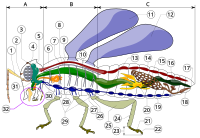
Photo from wikipedia
PurposeProper humeral head (HH) sizing is critical to success in anatomic shoulder replacement for management of glenohumeral arthritis. In this study, we evaluate the accuracy and reliability of using non-articular… Click to show full abstract
PurposeProper humeral head (HH) sizing is critical to success in anatomic shoulder replacement for management of glenohumeral arthritis. In this study, we evaluate the accuracy and reliability of using non-articular landmarks on conventional radiographs for HH templating.MethodsAnatomic HH replacement was performed on five non-arthritic shoulders, from fresh adult cadavers. Pre-operative and post-operative radiographs and 3-D CT scans were obtained. Humeral head size was determined using the articular surface and three extra-articular landmarks (inner aspect of the lateral cortex, the medial footprint of the rotator cuff, and the medial calcar). Two independent observers performed each measurement twice to evaluate reliability. The accuracy was assessed by subtracting the mean values from both the 3D-CT and the implanted HH size measurements.ResultsIntraclass correlation coefficient for Observer 1 and 2 for the three-point method showed excellent test–retest reliability 0.996 (95% CI 0.994–0.998) and 0.997 (95% CI 0.995–0.998), respectively. Inter-observer ICC for the three-point method was 0.996 (95% CI 0.994–0.997) showing high level of precision. The three-point method was overestimating the size of the HH (to 3D-CT) with 0.46 ± 0.61 mm on average. The three-point method predicted the size of the HH within 1 mm of the implanted head size showing very high accuracy. The center of rotation (COR) for the three-point method was within 1.34 mm of the (COR) of the articular surface.ConclusionThe three-point measuring technique using conventional radiographs may be useful to predict the HH size using extra-articular landmarks within a small margin of error. This method is simple, cost effective and has high level of precision.Level of evidenceBasic Science Study; Anatomic and Imaging Study.
Journal Title: Surgical and Radiologic Anatomy
Year Published: 2017
Link to full text (if available)
Share on Social Media: Sign Up to like & get
recommendations!